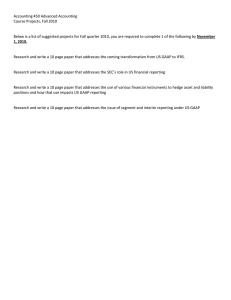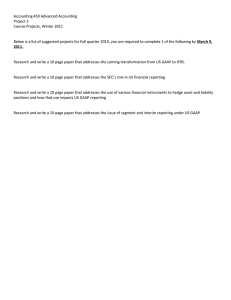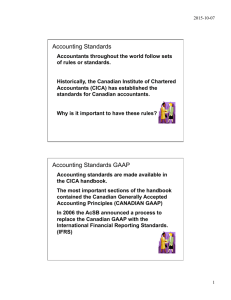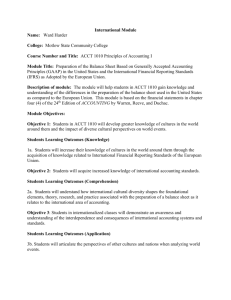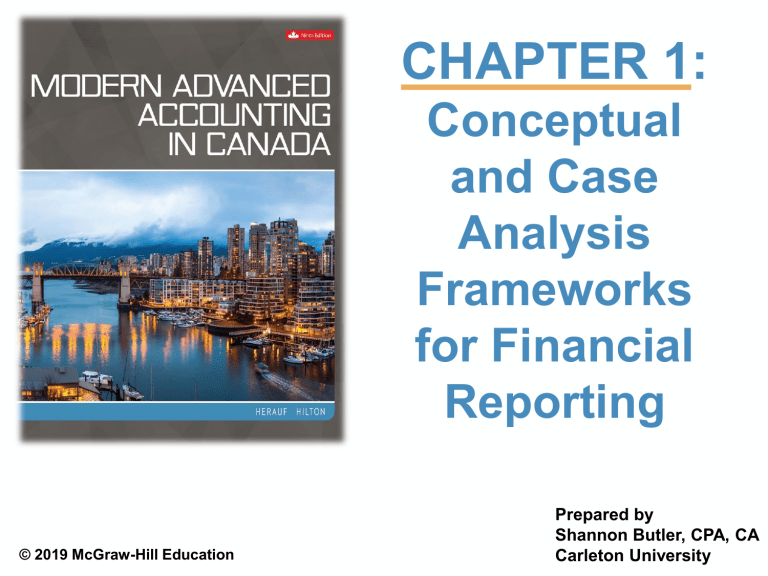
CHAPTER 1: Conceptual and Case Analysis Frameworks for Financial Reporting © 2019 McGraw-Hill Education Prepared by Shannon Butler, CPA, CA Carleton University Learning Objectives LO1 Describe and apply the conceptual framework for financial reporting. Describe how accounting standards in Canada are tailored to different types of organizations. LO2 LO3 Identify some of the differences between IFRS and ASPE. LO4 Analyze and interpret financial statements to assess the impact of different accounting methods on key financial statement ratios. LO5 (Appendix 1A) Apply the case analysis framework to solve accounting and reporting issues. 2 The Conceptual Framework for Financial Reporting The Conceptual Framework for Financial reporting is a document found just prior to IFRS in Part 1 of the CPA Canada Handbook. Main items include: • • • • The objective of general-purpose financial reporting Qualitative characteristics of useful financial information Underlying assumptions Definition, recognition, and measurement of the elements of financial statements All accounting practices should be traceable back to and supported by the conceptual framework. 3 The Conceptual Framework for Financial Reporting Part 2 Professional judgement is the ability to make a decision in situations in which the answer is not clear-cut. Lots of judgement is involved when preparing financial statements. Judgment is involved when adopting accounting policies, making estimates, and writing the notes to the financial statements. Financial statements should present what really happened during the period: that is, they should tell it how it is. 4 Accounting Standards in Canada The CPA Canada Handbook contains five parts as follows: Part # Applicable To: I II III IV Publicly accountable entities Private enterprises Not-for-profit organizations Pension plans V All entities not yet using other parts Name for Standards IFRS ASPE Pre-changeover GAAP 5 GAAP for Publicly Accountable Enterprises At one time, Canada intended to harmonize its standards with those of the United States. Canadian publicly accountable enterprises have to report under IFRS. Part I of the CPA Canada Handbook contains IFRS. IFRS allows the use of fair values and optional treatments to a greater degree than pre-changeover Canadian GAAP (Part V of the CPA Canada Handbook). 6 GAAP for Private Enterprises In the 1970s there was a lot of discussion in Canada about Big GAAP versus Little GAAP, wondering if there should be different standards for big companies and little companies. Eventually the concept of Big GAAP/Little GAAP was abandoned. There were a few other approaches over time but in 2006 when the decision was made to adopt IFRS there was a task force in place to determine what private companies should do. 7 GAAP for Private Enterprises Part 2 In 2009, it was decided that private companies would have a separate part of the CPA Canada Handbook dedicated solely for them. Part II of the CPA Canada Handbook contains GAAP for private enterprises. Private enterprises can report under either IFRS or ASPE. 8 IFRS versus ASPE ASPE sometimes allows a choice between different reporting methods. Key differences between IFRSs and ASPE include: • disclosure requirements • impaired loans • revaluation and depreciation of components of property, plant and equipment • impairment losses and subsequent reversal of loss • development costs 9 IFRS versus ASPE Part 2 Key differences between IFRSs and ASPE include, continued: • post-employment benefits • Actuarial gains/losses • Income taxes • interest capitalization • Compound financial instrument • Preferred shares in tax planning arrangement • Value of conversion option for convertible bonds • Lease accounting by lessee 10 Analysis and Interpretation of Financial Statements Financial statement analysis involves reviewing, evaluating, and interpreting the company’s financial statements. Common-sized financial statements make it easier to see the relationship between financial statement items in terms of percentages. When companies in the same industry use different accounting policies, it may be necessary to adjust the financial statements of one of the companies to make the statements more comparable. 11 Analysis and Interpretation of Financial Statements Part 2 Different accounting methods have different impacts on key financial statement ratios. We will focus on the following key ratios: Ratio Current ratio Debt-to-equity ratio Return on assets Return on equity Formula Current Assets ÷ Current Liabilities Total debt ÷ Shareholders' equity Income before interest & taxes ÷ Total assets Net Income ÷ Shareholders' equity What Is Measured Liquidity Solvency Profitability of assets Profitability of owners' investment When determining the impact on ratios of changes in reporting methods, we must consider the impact on both the numerator and the denominator. 12 Appendix 1A: A Generic Approach to Case Analysis Generic Framework for Case Analysis: I II III IV V VI Determine Your Role and Requirements Identify Users and Their Needs Given the Case Environment Identify and Rank Issues Identify Viable Alternatives for Each Major Issue Analyze Alternatives Using Criteria for Resolving Communicate Practical Recommendations/Conclusions 13 I: Determine Your Role & Requirements The first step is to determine who you are in the context of the case. The key requirements are often found in the last two paragraphs of the main body of the case. 14 II: Identify Users and Their Needs Given the Case Environment Define all the other characters in the case. The other characters will be seeking your expertise in financial matters, consider their needs. When focusing your task on the user’s needs, always consider the environment in which you both operate. 15 III: Identify and Rank Issues Issues are usually ranked based on controversy, errors, and complexity. Do not rank an issue as important only because you know a lot about the subject. Rank items solely on their importance to the other characters in the case. 16 IV: Identify Viable Alternatives for Each Major Issue Very few case issues will have one correct answer. You will need to create various possible solutions to each case issue. The alternatives should be relevant and viable for the client’s unique situation. 17 V: Analyze Alternatives Using Criteria for Resolving For each issue listed on your case plan, an analysis of the previously identified alternative should be performed. This may include quantitative and or qualitative forms of analysis. 18 VI: Communicate Practical Recommendations to Users Your answer to the case should be in the form required by the question. It should provide clear, practical recommendations based on our analysis and should directly address the identified user’s needs. Your solution should demonstrate the organizational skills required of a professional person. 19 A Framework for Solving an Accounting and Financial Reporting Case I: Determine Your Role and Requirements II: Identify Users and Their Needs Given the Case Environment III: Identify and Rank Issues IV: Identify Alternatives for Each Given Issue V: Analyze Alternatives Using Criteria for Resolving VI: Communicate Practical Recommendations/ Conclusions to Information Users 20

